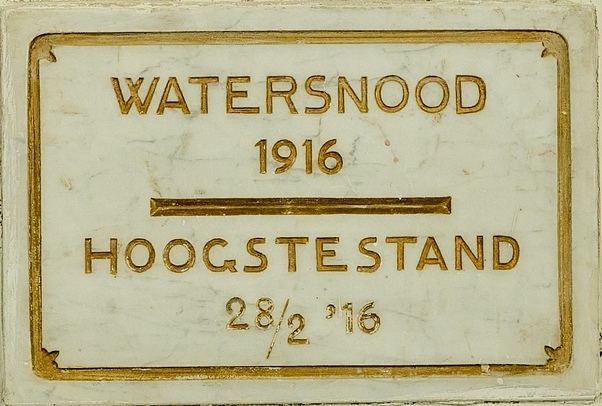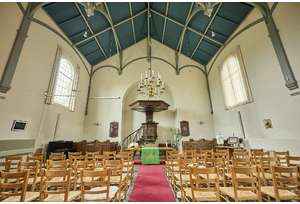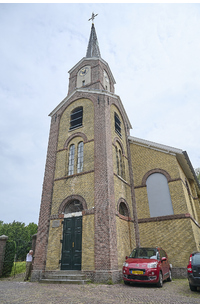A terrible storm causes a major tragedy in Amsterdam North. The dykes break, houses are flooded and the Nieuwendammerchurch does not escape the calamity either.
Location
Nieuwendammerkerk
Brede Kerkepad 8
Type
Church
Religious community
Protestant Church in Amsterdam, formerly known as Dutch Reformed Church
Object
Commemorative stone of the flood catastrophe
Maker and date
Maker unknown
1916
Visit
To be viewed on location
The last meeting before the storm
On 13 January 1916 at eight o'clock in the evening, the church council of the Nieuwendammer church meets under the leadership of pastor Wierenga. Despite the ‘fearful storm and gusts of rain’, almost everyone is present. Even though the weather is ominously bad, the members of the church council cannot guess what calamity awaits them.
That night, the dykes break. The villages in what is now Amsterdam-Noord are almost completely flooded. People lose their homes and many cattle drown. A chaotic situation ensues with most residents being evacuated to Amsterdam. Because the city had already had to deal with thousands of fleeing Belgians during World War I, emergency help quickly arrives.
As if the situation were not bad enough, February brings two more storms. Many of the houses that remained standing in January are still destroyed by the storms. Nieuwendam is also hit hard in February. The water in the church rises to 0.99 metres, but fortunately the church building remains standing. Other churches in the area are less lucky. As quickly as possible, beams (wooden planking) are constructed, making the church and houses accessible again.
Church council
The church council (consistory) of a local protestant community, according to the Dutch Confession of Faith, is formed by the reverend, elders and deacons. The church council oversees church services, education, and the administrative, material and financial affairs of the church.
A tragedy with major consequences
Due to the flood disaster, the poor villages of Noord suffer economically in the years that follow. After much insistence from the villages, they are annexed by Amsterdam in 1921. However, it will take decades for the silted land, nature and population to recover from the events. Amsterdam-Noord is not the only place to face major floods. Dykes break in several places in the Netherlands. The 1916 floods were a decisive argument for the government to agree to build the Afsluitdijk and reclaim parts of the Zuiderzee. The Netherlands has not experienced a storm disaster from the Zuiderzee since then.
Vera Mijnheer
Employee Protestant Church Amsterdam
Thanks to
Netty Lith
Treasurer Nieuwendammerkerk
Koos Lith
Community member Nieuwendammerkerk
Wim Gortzak
Community member Nieuwendammerkerk
Remmy Mastenbroek
Community member Nieuwendammerkerk
Last edited
October 14, 2024
Flood disaster memorial stone in Nieuwendam, maker unknown, 1916, marble, 25 x 37 cm. Collection Protestantse Kerk Amsterdam. Photography Robert Westera.
Interior and exterior: photography Robert Westera.
Nieuwendam at the time of the 1916 flood disaster, maker unknown, 1916-1920, five photographs pasted together and framed, 36 x 142 cm. Collection Protestantse Kerk Amsterdam. Photography Robert Westera.
Coach house of Dr Honing, flood 1916, N'Dam, maker unknown, picture postcard, 1916. Collection Stadsarchief Amsterdam.
Breedijk, Y. en W. Halbertsma eds., Nood aan den dijk: Watersnood 1916: Buiksloot – Durgerdam – Holysloot – Nieuwendam – Ransdorp – Schellingwoude – Zunderdorp (Ransdorp en Amsterdam-Noord, 2016).
Geel, van B. en D. Groffen eds., Nieuwendam: monument aan de noordelijke IJ-oever (Amsterdam-Noord, 2003).
Stadsarchief Amsterdam inv.nr. 180.169, Notulen van de vergaderingen van de kerkeraad (1912-1969).









